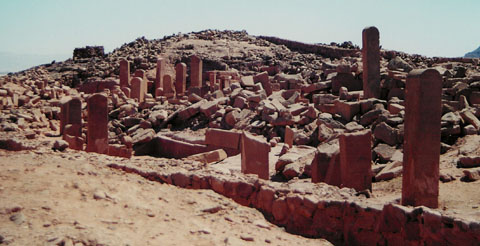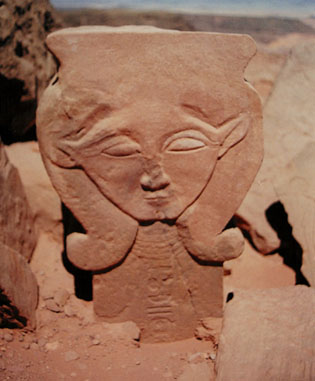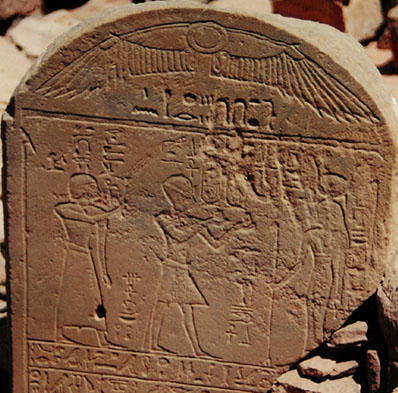
The Temple of Hathor at Serabit el-Khadim

This Temple of Hathor is one of seven major ancient temple sites in Egypt dedicated to Hathor. Hathor is the Ancient Egyptian Neter embodying the Divine attributes of love, music, song, dance, protectress of women and children. She is represented by the symbology of the sistrum, cow goddess horns with solar disc, and suckling imagery. Meet the fourteen aspects of Hathor.


She is known by many names:
Lady of Turquoise
Lady of Heaven
Golden One
The Golden Goddess
Golden One of Women
Cow of Gold
Mistress of Dendera
Lady of Dendera
Lady of All
Mistress of All
Mother of All Gods
Mistress of the Vulva
She of the Red Cloth
Mistress of the Red Cloth
Lady of Byblos
Mistress of the Sycamore
Lady of Acacia
Mistress of the West
Mistress of the Northern Sky
Lady of Happiness
Mistress of Joy
Mistress of Music, Dance, Celebration
Lady of Dance
Queen of Harp Playing
At Serabit el-Khadim she is known as Lady of the Turquoise. There are several temple reliefs that reveal the role of Hathor in the transformation of the Pharaoh to Divine being of Priest-King. There is an image that depicts Hathor suckling the Pharaoh, offering her milk as an elixir of metamorphosis. The breast milk of the Neter contains a high concentration of the enzyme telomerase in the colostrum. Telomerase can prevent the deterioration of the end caps (telemeres) on the DNA strands during cell replication thus producing an anti-aging effect. The imagery is demonstrating one of the keys to immortality.

Another carved stone tablet relief shows Hathor offering the Pharaoh the Ankh, eternal life through the breath and the Menat necklace, life on Earth and Hereafter rebirth to the stars. Sobekhotep, "Overseer of the Secrets of the House of Gold", is standing behind her offering conical cakes. These cakes are similar to the shewbread, manna, Star Fire and are of white powder gold. This mono-atomic high-spin superconductor state of gold that is produced through a high fire alchemical process is consumed by the Pharaoh to feed his lightbody.
This temple site was excavated by Petrie in 1904 on Mount Horeb. This mountain is believed by some to be the actual Mount Sinai, upon which Moses received divine guidance and the tablets of divine law. This temple was an alchemical foundary site that produced white powder gold, the sacred fire stone, mfkzt.
The journey to the Temple of Hathor at Serabit el-Khadim is into the Sinai Desert by sand jeep. There are no paved roads to the base of the mountain. Our driver was a Bedoiun who had grown up in this region and could navigate the desert gracefully and effortlessly. We arrived as the base of the mountain after several hours journey by jeep from St. Catherine’s Village. We rested at a small Bedouin village in the home of a local family. We ate a light breakfast and proceeded to the trailhead for our journey up to the top of the mountain. The trail to the temple has an elevation gain of over 2600 feet above sea level and is somewhat rigorous.
There are many elements to this exciting experience. The sound of the high mountain desert wind still sings in my heart, calling me to come "Back to Egypt".
Journey by jeep caravan to the trailhead of Mount Horeb.
Sit with a Bedouin family in their open air home.
Climb the mountain that the Pharaoh’s climbed to receive communion with Hathor.
Breathe the breath of fire in the Holy of Holies, the sacred cave of Hathor and feed your Lightbody the food of the Neters.
Join us for the Rising of your Phoenix.
This excursion is offered as an add-on at the end of the pilgrimage along the Nile.
|
Itinerary |
Home Page |
Registration |
|
Webmaster @ Elements of Health All photos are copyright protected by Elements of Health |
Last updated 02/09/09.